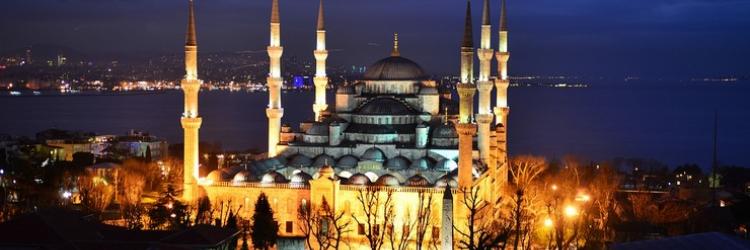Travel destinations Comments: 0 May 29, 2017
Being the only city that straddles two continents, Asia and Europe, Istanbul has been coveted by many empires due to its affordable position and historical and cultural richness that is still present nowadays. This great metropolis was established around 1000 BC and was ruled by many empires, such as the Byzantine Empire and the Ottoman Empire, which have left traces of their rule in numerous remnants scattered around the town that illustrate Istanbul’s glorious history which impresses every visitor. With more than 13 million citizens, which is the same as the population of Belgium, Istanbul is one of the most populous cities of Europe and its numbers are still rising. While it isn’t the capital of Turkey, Istanbul is the largest city of the state in which 99% of population are Muslims.
Aya Sofya: Built on the order of Byzantine Emperor Justinian in 536 AD, Aya Sofya stands proudly as an evidence of Justinians’s wealth and technical and architectural ability of his empire. The legend has it that upon entering his completed church, Justinian said in amazement: "Glory to God that I have been judged worthy of such a work. Oh Solomon, I have outdone you!" Following the tradition, the area around the emperor's throne within the church was and still is thought to be the official center of the world. Through its conversion to a mosque, after the Ottoman armies conquered Constantinople, to its further conversion into a museum in the 20th century, the Aya Sofya has remained one of Istanbul's most cherished landmarks.
Topkapı Palace (Topkapı Sarayı): Built by Mehmet the Conqueror in the 15th century, the Palace came into the hands of the sultans of the Ottoman Empire who ruled from this glorious palace beside the Bosphorus up until the 19th century. This vast complex offers insight into the dazzling display of Islamic art, and nothing short of amazing are the richly decorated rooms with opulent courtyards which are famous for their detailed hand-painted tile-work, surrounded by massive walls. In the spotlight of the palace is the the Harem (where the sultan's many concubines and children would spend their days); the Second Court, where you can walk through the vast Palace Kitchens and stand in awe at the dazzling interior of the Imperial Council Chamber; and the Third Court, known as the Sultan’s private rooms. The Third Court is home to the Imperial Treasury, where a load of glittering artifacts and precious gems that will make your eyes sparkle. Those who come with the intention of spending just a couple of hours at the Topkapi Palace will be disappointed - one needs more than a day to fully explore this magnificent palace.
Blue Mosque (Sultan Ahmet Camii): Sultan Ahmet I built this mosque as a gift to its capital between 1609 and 1616 and since that time the mosque has been known by the name the Blue Mosque thanks to its unique set of colors and interior decoration of tens of thousands of İznik tiles, thus making it one of the finest achievements of Ottoman architecture. A great sightseeing hype of a trip to Istanbul is wandering among the gardens sandwiched between the Blue Mosque and the Aya Sofya to experience their dueling domes in all their glory. A special experience is hearing prayers echoing out from the Blue Mosque's minaret.
Directly behind the Blue Mosque is the Arasta Bazaar; a great place for a shopping stop as the handicraft shops here sell high-quality souvenirs .Those who prefer historical sights to shopping head to the Great Palace Mosaic Museum, which is tucked between the Arasta Bazaar and the mosque. This small museum displays the 250-square-meter fragment of mosaic pavement that was excavated in the 1950s here. Excellent information panels explain the mosaic floor's recovery and subsequent rescue.
Basilica Cistern: Just like Aya Sofya, this subterranean structure was commissioned by Emperor Justinian and built in 532. The largest surviving Byzantine cistern in İstanbul, it was constructed using 336 columns, many of which were salvaged from ruined temples and feature fine carved capitals. Its symmetry and sheer grandeur of conception are quite breathtaking, and its cavernous depths make a great retreat on summer days.
Grand Bazaar (Kapalı Çarşı): For many visitors, sightseeing in Istanbul is as much about shopping as museums and monumental attractions, and the Grand Bazaar is where everything is put into one. Known as the world's first shopping mall, this enormous covered market is taking up a whole city quarter, surrounded by thick walls, between the Nure Osmanıye Mosque and Beyazıt Mosque, and with more than 300 shops where everyone can find something that suits their tastes. The entrance to the Bazaar is enabled through one of eleven gates which lead to a maze of vaulted ceilings and stalls selling everything one can possibly imagine.
Süleymaniye Mosque: Together with the Aya Sofya, the Süleymaniye Mosque is one of the most recognised landmarks of Istanbul, built for Süleyman the Magnificent by the famed Ottoman architect Sinan between 1549 and 75. The harmonious proportions and unity of design of the interior of the mosque is nothing in comparison to its soaring 53-meter-high dome. Which contrasts the tranquil garden area is an interesting Ottoman cemetery that is also home to the tombs of the Sultan Süleyman and his wife Haseki Hürrem Sultan.
Spice Bazaar (Mısır Çarşısı): The Spice Bazaar is the place where food lovers tend to gather to taste some of the most famous specialties of Turkey: lokum (Turkish delight), dried fruit, nuts, herbs, and of course spices, as the name suggests.
Possibly the most perfectly pretty mosque in Istanbul, Rüstem Paşa Mosque is home to the most stunningly preserved İznik tiles in the city. While the Blue Mosque is getting all the glory, it's here - covering both the exterior courtyard walls and the mosque interior - that you'll find the best examples of these gorgeously intricate hand-painted tiles in blues, reds, and greens. Due to the fact that it is not as famous as the Blue Mosque, this mosque is a perfect choice for those who can’t stand the crowds usually seen at the Blue Mosque, which gives the perfect opportunity to look at the tiles up close.
Yedikule Fortress (Yedikule Hısarı): While it may be a drag to take the suburban train to reach the fortress, getting there is well worth it. This fortress, built in the 5th century by the Emperor Theodosius II, was part of the southern section of Constantinople's defensive walls. A sight to look at is the mammoth arch, Porta Aurea, also known as the Golden Gate, with doors plated in gold. The fortress had many purposes during history, it used to serve as a prison and execution place, as well as for defense. The fortress can be climed today because it was renovated in recent years and one can enjoy a spectacular view over the town..
While the Big Four (Aya Sofya, Topkapı Palace, Blue Mosque, and Grand Bazaar) are definitely worth seeing, other attraction not so grand in size, but grand in their importance are dissipated throughout the city for those who have observant eye.
As a metropolis, Istanbul is connected to all major cities on the Balkans, and Europe, as a matter of fact, but also to some Middle East destinations and the whole world, through its two airports, Ataturk International Airport and Sabiha Gokcen Airport, but it also has an outstanding intercity and international connection via Istanbul International Bus Terminal. An interesting route to take between Europe and Asia is a rail tunnel beneath the Bosphorus, Istanbul's regional commuter rail line called Marmaray.


 RS
RS  ME
ME  HR
HR  BA
BA  RU
RU  MK
MK  AL
AL  ES
ES  DE
DE  IT
IT  CN
CN  NL
NL  SE
SE  FR
FR 






Write a comment